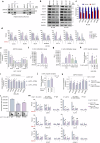Tailoring a novel colorectal cancer stem cell-targeted therapy by inhibiting the SMYD3/c-MYC axis
- PMID: 40588481
- PMCID: PMC12209437
- DOI: 10.1038/s41392-025-02290-z
Tailoring a novel colorectal cancer stem cell-targeted therapy by inhibiting the SMYD3/c-MYC axis
Abstract
Cancer stem cells (CSCs) are responsible for colorectal cancer (CRC) chemoresistance, recurrence, and metastasis. Therefore, identifying molecular stemness targets that are involved in tumor growth is crucial for effective treatment. Here, we performed an extensive in vitro and in vivo molecular and functional characterization, revealing the pivotal role of the lysine methyltransferase SET and MYND Domain Containing 3 (SMYD3) in colorectal cancer stem cell (CRC-SC) biology. Specifically, we showed that SMYD3 interacts with and methylates c-MYC at K158 and K163, thereby modulating its transcriptional activity, which is implicated in stemness and colorectal malignancy. Our in vitro data suggest that SMYD3 pharmacological inhibition or its stable genetic ablation affects the clonogenic and self-renewal potential of patient-derived CRC-SCs and organoids by altering their molecular signature. Moreover, we found that SMYD3 stable knock-out or pharmacological inhibition drastically reduces CRC tumorigenicity in vivo and CRC-SC metastatic potential. Overall, our findings identify SMYD3 as a promising therapeutic target acting directly on c-MYC, with potential implications for countering CRC-SC proliferation and metastatic dissemination.
© 2025. The Author(s).
Conflict of interest statement
Competing interests: Italian patent application. Filing date 13.10.2022. Patent applicant: ISTITUTO DI RICOVERO E CURA A CARATTERE SCIENTIFICO “SAVERIO DE BELLIS”. Name of inventors: Alberto Del Rio and Cristiano Simone. Application number: IT202200021138. All other authors declare no competing interests.
Figures









References
-
- Deo, S. V. S., Sharma, J. & Kumar, S. GLOBOCAN 2020 Report on Global Cancer Burden: Challenges and Opportunities for Surgical Oncologists. Ann. Surg. Oncol.29, 6497–6500 (2022). - PubMed
-
- Yang, Y. et al. Small-molecule drugs of colorectal cancer: Current status and future directions. Biochim Biophys. Acta Mol. Basis Dis.1870, 166880 (2024). - PubMed
MeSH terms
Substances
Grants and funding
- IG-23794/Associazione Italiana per la Ricerca sul Cancro (Italian Association for Cancer Research)
- ID26678/Associazione Italiana per la Ricerca sul Cancro (Italian Association for Cancer Research)
- ID-31217/Associazione Italiana per la Ricerca sul Cancro (Italian Association for Cancer Research)
- IG19172/Associazione Italiana per la Ricerca sul Cancro (Italian Association for Cancer Research)
- SG-2019-12371540/Ministero della Salute (Ministry of Health, Italy)
LinkOut - more resources
Full Text Sources
Medical

